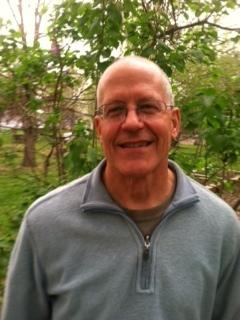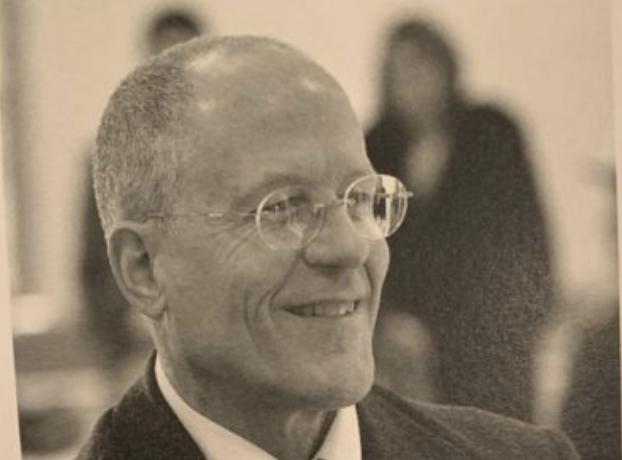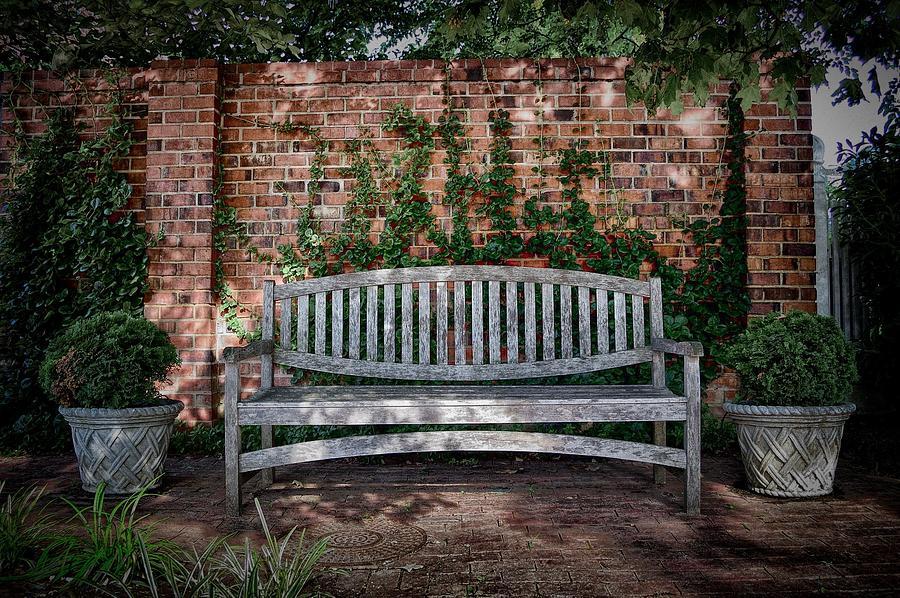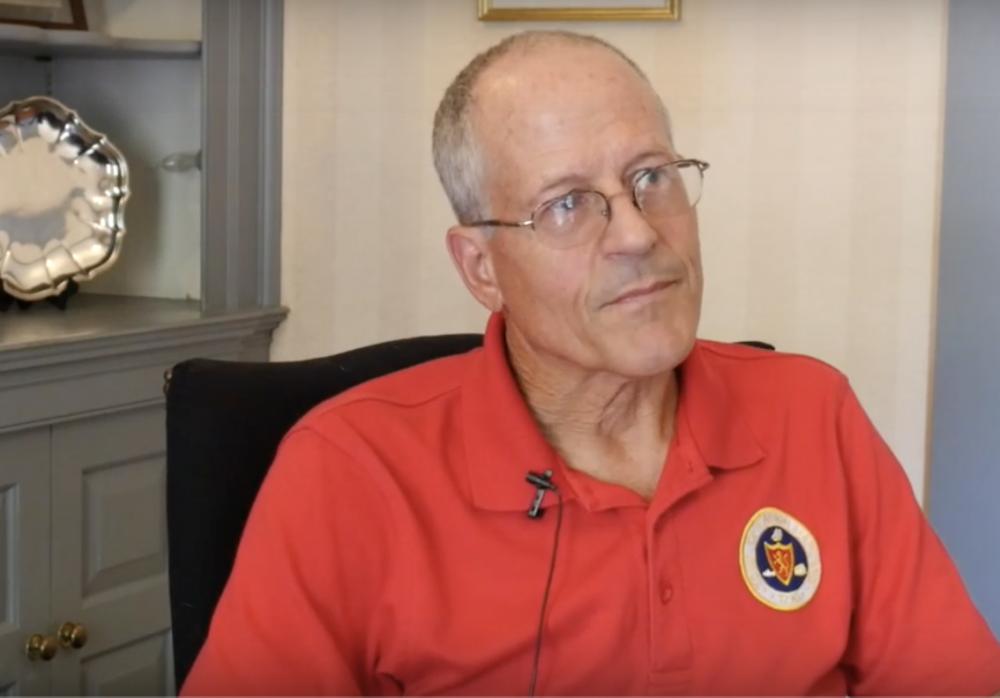Family, friends, colleagues and members of the community gathered Saturday morning to celebrate the life of John Ford, who served Easton for decades as a member and chairman of the town planning commission and as a member and president of the town council.
Ford was a longtime staffer at the Chesapeake Bay Maritime Museum and served on numerous community boards.
Karen Kaludis welcomed those who gathered at the Talbot County Auditorium at Easton High School to honor and celebrate her longtime friend. Outside, Easton Volunteer Fire Department trucks displayed the U.S., Maryland, Talbot County and Easton flags.
“We are here to celebrate that we were so very lucky to have found John Ford and that he found us, each and every one of us,” Kaludis said. “And that we, that you, that I, can forever see the world through his eyes. It is his everlasting gift to us.”
Kaludis later recalled the warm afternoon she and her husband Tom, longtime friends of John and Peggy Ford, spent with the Fords and another friend on Nov. 16, shortly before John’s stroke, tying the day’s events to memories at various landmarks around town.
“It was a beautiful November day, full of color, the air was crisp and fresh. We were having an Easton ‘Our Town’ kind of afternoon,” she said. The main purpose that day was to see the artwork of John’s older sister Mary at the Academy Art Museum and at the Talbot County Free Library.
The Academy was where the Fords and Valliants had spent many years taking dance lessons together and where the Fords had attended numerous openings.
As they headed to the library, they crossed Washington Street on the way to the courthouse green. Kaludis recalled the many holiday parades along Washington Street and St. Patrick’s Day parades in which the Fords rode a golf cart emblazoned with “John Ford, president of the town council.”
During the parades, numerous attendees would call out not to John, but to Peggy, a longtime teacher. “Every kid she taught, every parent of a kid, every grandparent of a kid, Peggy was the star, he knew it and loved it that way,” she said.
“As we often would say, we said ‘let’s go see Freddy,’” Kaludis said. “John was an inaugural member of ‘Fred’s Army’ and a frequent pilgrim to the statue to pay respects.”
She said she remembered John on the courthouse green when the statue was dedicated and during all the Frederick Douglass Day celebrations, particularly in 2019.
“I see him in his Town of Easton polo shirt, standing on the green, taking it all in,” she said. “The middle school band, he loved that, the high school band and the students who spoke, he loved it, he loved to see and hear the young people participate.”
On the way to the library, they met a girl, about 5, and her mother. The girl “was jumping out of her skin with excitement and singing, ‘I’m going to the library, I’m going to the library.’
“John smiled, that knowing smile of one book lover to another. The library, the Talbot County Free Library, another important Easton landmark for John — John the reader, the scholar, the worshipper of the written word — where he and Peg and Ben would visit religiously to find the many treasures that the library holds.
“Memories of the lectures John attended there to hear his mentor John Miller and later to lecture with his mentor John Miller at the library. Also to hear Kenneth Morris Jr. and renowned Douglass and Lincoln scholar David Blight. And most recently — and I think this was his proudest moment at a lecture — to hear local author and Peg’s second-grade student Casey Cep speak.”
Leaving the library, the group went up Federal Street to Goldsborough and enjoyed pie and ice cream. “We sat, we laughed, we ate, and we talked the way old friends talk, the comfort of knowing each other through and through. John had apple pie and relished every bite of it, the way he relished his life. A hometown boy eating apple pie on a fall afternoon. You can’t make this stuff up.”
They stopped at The Dragonfly to see John’s sister-in-law and his brother Steve popped in “and we talked the easy talk of people who belong to each other.”
They left there, passing Out of the Fire, “site of so many date nights for the four of us, celebrating birthdays, anniversaries, promotions, celebrations and always ending with three bowls of ice cream and four spoons.”
Continuing onto Harrison Street, Kaludis said it was the site of so many memories, including outdoor concerts on the street and Star Democrat reporter Chris Polk taking pictures of “Peggy and John, dancing and laughing.”
They passed the Tidewater Inn, where the couples enjoyed numerous meals on the patio and decades of Festival of Trees galas, “all dressed up.”
Next stop was the corner of Dover and Harrison streets, where they watched the crowd pour out of the Avalon Theatre, “the crown jewel of Easton, another special place for John. Where he could enjoy his passion for music and the arts, where he performed himself in the holiday show alongside Peg.
“As the people poured out of the Avalon Theatre, I can still see John standing on the corner, watching, being happy in his town.”
They walked down Harrison, past the town office, “a place of major importance for John. So much happened there, so much was accomplished there, actions taken and solutions found that would benefit generations to come. A place where he had so many dear friends and colleagues. You were his town family.”
They continued along Harrison, “where the buzz of the Waterfowl was still fresh in our minds and the excitement of Plein Air Quick Draw sale lingering.
“This was our town, his town. I can still see John’s face, smiling with his Peg by his side. We hugged, joking, laughing and said ‘See ya!’ Perfect day in our town, his town, your town, the town where he lived, the town that he loved, the town where he belonged, John’s paradise found.”
 John and Peggy’s son Ben said, “I learned a lot from my father and we did a lot of amazing things together during my life. I will always appreciate what he and my mom instilled in me. They instilled a love of travel, the joys we had sitting quietly reading a book, of allowing me to ramble on foot and on bike down the rail line — which now is rails to trails, but at the time was barbed wire and prickle bushes and stuff like that …”
John and Peggy’s son Ben said, “I learned a lot from my father and we did a lot of amazing things together during my life. I will always appreciate what he and my mom instilled in me. They instilled a love of travel, the joys we had sitting quietly reading a book, of allowing me to ramble on foot and on bike down the rail line — which now is rails to trails, but at the time was barbed wire and prickle bushes and stuff like that …”
When he was 8 or 9, Ben said he decided to create a miniature Native American dugout canoe for a history project. To do so, you burn a log and scrape out a trough with sharp rocks and oyster shells.
Native peoples would have used softer woods, such as cedar or pine. John Ford chose a dense chunk of oak.
“It took forever to char out that middle bit and scrape it and we were using oyster shells and sharp stones and I was 9 and getting bored and frustrated. I asked my dad, why can’t we use the propane torch to burn the wood out and maybe a chisel, maybe a rasp, maybe a hatchet.
“He thought about it, as he did when most people asked a question or said something, he thought about it for about 20 seconds, and he turned and looked at me and said, ‘Do you think Native Americans had those things? We can do that and I’m OK with it. But you told me the project was about learning how to build a dugout canoe like the people here would have built then. When you present the project, do you want to present it as an experience or as an object? We can make it easier, but do you want to or do you want to do it right?
“So we did it right. It took forever. It took a really long time.
“My father was a good man. He often used his passion for things to do good works for others. His lifelong love of learning and reading led him to work pretty hard to pass that enjoyment onto the people around him. Whatever it was, he did it right. Whether it was his job, involvement in this community, his work or his family.
Rabbi Peter Hyman, John Miller and John Ford recently taught a Shakespeare class on “The Merchant of Venice” at the Chesapeake Forum, which Ford helped found and for which he was board president.
“We are a congregation convened by death’s summons,” Hyman said. “We are a community linked by loss and gripped by grief. We are a family ordered to this spot and to this place by a call all to early announced and we are stunned, heartbroken and bewildered.
“We sit in soul-shattering silence and ask why. Why did this happen? Why did this happen now? There was so much more to do, so much more life to live, dreams to fulfill, projects to complete, people to help, causes to champion, wisdom to share and love to give.
“Death cannot rob us of the good we have done, the help we have given, the repair we have made to the world that surrounds us and the world in which we live,” Hyman said. “And so, let me suggest, while the irrevocable decree has gone forth, claiming our friend John, it is not his death that compels us and requires his presence. It is his life and how he lived that brings us here.
‘We come not to recount John’s death, we come to praise his life and to learn from his being lessons to apply to our own lives. No matter how old a person is, when death strikes that person is never old enough when it’s someone you love. And we loved John.
Hyman admitted he was going to begin his remarks with a rant, with anger at God … “when the world in which we live is in dire need of compassionate, sensitive, responsive and caring people, how dare God take a one such as John from our midst” but changed his mind.
“John was a gift to us, a rare soul, and John bequeaths to us a precious gift and that gift is the example of how to be, how to treat people, how to respond to the world in a way that makes a difference.
“John was a man of conviction, of principle, of confidence, but his strength was always accompanied by thoughtfulness and gentleness, by kindness.… John taught us that you could be strong without being cruel. He taught us that those who confuse kindness for weakness are fools.
“John was a peacemaker. His affable nature and his calming presence put us at ease. Every problem has a solution. Every challenge contains an opportunity. John was a reassuring presence that helped us solve and resolve the difficulties that daily confront us. Smart, insightful, interested in those around him, he bequeaths us a model of leadership that says the dream is possible and the possible is doable.”
John Miller, who became the Chesapeake Bay Maritime Museum’s development director in 1998, taught numerous literature classes with Ford at the museum’s Academy for Lifelong Learning, which Ford helped create. ALL recently became the Chesapeake Forum.
“It is for us the living to be dedicated to the unfinished work that John’s life so notably advanced during his short time with us. His compassion, his humility, his love for his neighbors as brothers and sisters,” Miller said. “John Ford was an intensely private person who played a very public role in this community. He knew that love’s first duty is to listen, to listen without judgment, to listen with compassion. These are the qualities of a great leader, of a great politician. They’re also the qualities of a great teacher. In addition to that, they’re also the qualities of a poet.
John Valliant was CBMM president when he hired Ford as the museum’s operations director nearly 30 years ago. Ford was the foreman at the Crockett Brothers Boatyard in Oxford when he applied for a job as the museum’s boatyard manager.
Through the interview process, Valliant knew he wanted Ford on his team and offered him the position of operations director instead. Ford agreed, but said he wanted to give his employer four months notice.
Asked why, Ford said he felt personally obligated to see the boatyard through its busiest time of the year.
“Classic John Ford,” Valliant said. “I took the long view and said to myself this is the type of person I want to depend on for the future of the museum.”
Ford played a critical role in the growth and success of the museum, but more importantly in the solution to problems, Valliant said. “He always put people first.”
“For me, his lasting legacy at the museum was something you can’t see,” Valliant said. “His innate ability to see both sides of an issue and bring people together for a common goal was invaluable.”
 Vicki Wilson, an officer of the Frederick Douglass Honor Society, said Ford, was “kind and caring and supportive.
Vicki Wilson, an officer of the Frederick Douglass Honor Society, said Ford, was “kind and caring and supportive.
“He had integrity, strength, intellect, and a sense of humor. … What we also witnessed again and again was John’s conviction…,” Wilson said. “He stood up and spoke up in such a strong yet gentle way about any wrong he witnessed in our town, our county, and in our community. Where he saw injustice, he spoke out. Where he saw he could make a difference, he actively participated in bringing about change. John did not wait to be asked, he volunteered.
“Our community has lost a true teacher of history, literature, justice, openness, commitment and most of all courage in spite of our surroundings.
“We are the worst off for losing him, but the best for knowing him.”
Kelly Moran served six years on the town council with Ford.
“John was so finely woven into the fabric of our community and our lives that surely all of our 16,000-plus residents have in some way been impacted by his service, directly and indirectly. People of Easton, you have been profoundly fortunate to have had a man of such character and integrity representing you in town government.
Moran first met Ford at a meet-and-greet when she was running for town council and told her the only qualification she needed was to “know how to listen.
“Articulate, thoughtful, wise, humble, he was a true master in the art of listening.
“John, may you rest in peace, dear friend, knowing that you have left this world having changed it for the better, having changed us for the better.”




